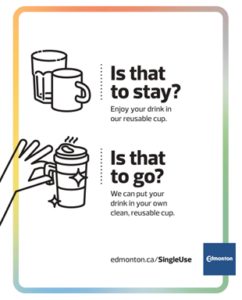Plastic pollution is a complicated problem that requires innovative thinking and policy solutions. Recently, we’ve seen Canadian governments take many different approaches to tackle the issue of plastic waste. From organizing local repair workshops to banning single-use items, governments of all levels are pushing the change in our packaging and consumption habits. People may be most familiar with recent bans on single-use plastic at the federal, provincial, and local levels. However, single-use item policies are progressing and innovating to not only reduce single-use item and plastic waste but also direct businesses and consumers towards reusable alternatives.
Many have asked the question, if we don’t use single-use plastic packaging, then what should be used instead? Arguments have been made for different single-use alternatives such as paper (recyclable, but highly resource intensive) and compostables (complicated by bio-plastics and other materials that can’t be composted locally). The issue with these alternatives is that they don’t eliminate waste. They replace one set of single-use materials with another. There is no “best” single-use alternative. Each has its advantages and disadvantages, but at the end of the day, still rely upon waste management and collection systems that we know are overwhelmed and unable to handle our current waste.
There was a time not too long ago when restaurants and fast food diners asked each customer if their meal was for takeout or dine-in. For dine-in orders, coffee was served in a ceramic mug and french fries in a reusable basket on a tray that could be returned to be washed and used over again. Some will say that reusable packaging for dining is an unrealistic ideal. We’d say that’s the furthest thing from the truth. In fact, it’s so possible, it’s how we used to dine before our reliance on single-use packaging grew so out of control. If reusable food ware systems were possible and viable 20 years ago, 50 years ago, even 70 years ago, why not embrace them once again for the sake of our health and the health of the planet?
Canadian municipalities with dine-in reusable policies
One solution that’s growing in popularity is requiring reusables for eat-in meals. The idea of adopting an on-site reusable dining policy is still relatively new in Canada. So far only one Canadian municipality has fully adopted a bylaw that specifically mandates reusable food service ware for on-site dining. The Town of Banff, Alberta adopted their new Single-Use Items Reduction Bylaw last month, which states that food businesses will be required to provide reusables for in-person dining beginning in January 2024.
According to the bylaw, businesses that serve food and drinks such as restaurants, cafes, and bars must provide reusable food ware, such as plates, bowls, cups, cutlery, and other accessory items, for any food or beverages consumed on-site. Businesses with dine-in services may only provide disposable food ware if the customer confirms that they are ordering the food for takeaway. All businesses serving food and beverages must have dishwashing facilities to clean the reusable food ware and provide adequate seating for customers (minimum of 10 seats). Banff has even included a requirement that all new businesses seeking to serve food and beverages in the town must plan for a minimum of 10 seats, on-site dishwashing facilities, and reusable food ware in advance to receive a license to operate. The City of Victoria, BC is also considering a similar bylaw, put forward to Council earlier this month.
The City of Edmonton implemented a different kind of reusable policy in their recent Single-use Item Reduction Bylaw. Restaurants must serve dine-in drink orders in reusable cups, and have a written policy for accepting customers’ reusable cups for to-go orders. While not all food ware is required to be reusable for on-site dining, eliminating the use of single-use cups for on-site dining is a major step forward. The municipality suggests that the new policy will have a positive impact on single-use waste, and will also save food businesses approximately 20 cents per cup. This type of policy is growing in popularity amongst Canadian municipalities that want to urgently address single-use waste, and they have benefited greatly from the example set by international governments.

Edmonton’s reusable cup information poster
International reusable dine-in policies
The State of California is the global leader for municipalities embracing the reusable dine-in policy for food and beverage packaging, which began with the City of Berkeley. In early 2019, Berkeley introduced their policy to mandate durable/washable food ware for serving customers that are eating on the premises. Since then many more cities and counties in the state have adopted similar policies.
Europe has had some very exciting developments in the adoption of reusable on-site dining recently. France, Germany, and Luxembourg have all taken on-site reusable policy to the national level. Starting January 1, 2023, policies to mandate reusable containers for on-site consumption came into effect for each country. While the details of the policies are slightly different (e.g. the number of in-house seats required for the policy to apply), the sentiment is the same– eliminate single-use food packaging waste at the source for on-site dining.
Restaurants such as McDonald’s were some of the first to transition to their reusable food ware in late 2022, debuting uniquely shaped containers for their french fries and chicken nuggets. This type of policy has sparked nationwide innovation and new ways of thinking about packaging design for food service. New reusable food serviceware introduced by McDonald’s in France this fall (pictured).


The benefits of reuse
The best news of all is that the shift towards reusable packaging for food service has a multitude of benefits. The most obvious benefit is the reduction in single-use packaging waste. We know that the solution to our single-use plastic problem is not replacing plastic with another single-use material. In France, an estimated 30,000 fast-food restaurants provide over six billion meals every year, generating approximately 180,000 tonnes of packaging waste. According to French environmental groups, 55 percent of that waste is generated by people dining on-site. By switching to reusables, thousands of tonnes of waste will avoid landfill and avoid ending up in the environment as pollution.
But the benefits aren’t only environmental. Most people look at the cost as a barrier for businesses looking to implement reusable systems. In practice, reusables have proven to be a money-saving initiative for food service businesses. ReThink Disposable conducted case studies on how the inclusion of reusable containers for on-site dining impacts a business’s bottom line and found that every single business studied earned a profit when they switched away from single-use. The average savings for a small business in California was estimated to be between $3,000 and $22,000 USD. Following the initial investment to purchase the reusables, businesses accrue these annual savings by avoiding the purchase of single-use food packaging every week, or every day in some cases. It was also determined that most businesses did not need to hire additional labour for washing reusables. A case study conducted across 11 Subway franchises in California found a reduction of 305,125 single-use items, with 4,367 pounds of waste avoided, and an ongoing annual savings of $7,458. Each Subway store invested only $120 to $300 on reusables to see these results.


Finally, reusables for on-site dining promote brand loyalty and community savings. Brand loyalty is an undeniable benefit for companies willing to make the transition to reusables and demonstrate a real commitment to the environment. As consumers, we want to have no-waste options available to us and be allowed the opportunity to reduce our single-use waste. Restaurants and cafes that make that possible are more likely to build a base of dedicated, returning customers. There are also community savings wherever waste is prevented and reduced. The municipality no longer has to pay to haul away that disposable waste, and the amount of litter reaching the local environment (67% of which is estimated to be food service packaging) decreases significantly. Every time a container is reused, waste decreases further, producing savings and benefits for the entire community.
This blog just scratches the surface of the benefits and possibilities of reusable packaging. On-site food service is a great place to start the transition to reusables because it’s a dining option where travel-friendly takeout disposables aren’t needed. While this type of policy has been slower to catch on in Canada, there has been great progress in recent months. It’s a promising step forward in waste reduction and we hope to see more governments adopt similar policies to promote reusability. Has your local government made a commitment to support reusables? Let us know in the comments!
